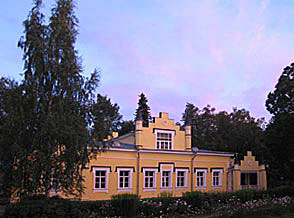The Old Russian estate Izvara was built on the site of ancient Novgorod settlement Vzvar of the Vodskaya Pyatina (Old Russian lit. ‘a fifth part’) region (one of the five territorial subdivisions belonging to the city state of Great Novgorod in 12th-15th centuries), which explains its historical and cultural characteristics. Vodskaya Pyatina was adjacent to the Izhora Elevation with its fertile soils, where the first settlements of Slavic and Finno-Ugric tribes appeared as early as the 10th-11th centuries. The word 'Vodskaya' derives from the name of the Finno-Ugric tribe vaddialaiset (called 'vod' in Old Russian) who occupied the southern coast of the Finnish Gulf up to the Luga River Estuary and hunted on the vast territories of the Izhora Plato.
The first record of Vzvar village dates back to the 15th century: the village got a mention in the census tax book of Vodskaya Pyatina of 1500 as belonging to Pokrovsky-Ozeretsky Pogost (parish) of Koporsky Uezd (district). An earlier history of the settlement is traced through archaeology. In 1993, during archaeological excavations initiated by the museum, several discoveries were made in the estate park, particularly a rhombus plate decorative temple suspension of Novgorod style made in late 12th – early 13th centuries accompanied by several ceramic fragments, suggesting that there had been a settlement on the site of the estate as early as in the 12th century. In 17th century as per the Stolbovsky Peace Pact of 1617 a part of Vodskaya Pyatina passed into possession of Sweden whereupon the village of Vzvar was renamed Isvarhof and became a Swedish settlement.
The first record of Izvara Estate (Myza Izvarskaya) can be found in Ingermanland census of 1711. In 1712 the estate belonged to M. Sheremetiev – the son of general field marshal M. Sheremetiev. Over the course of the 18 century the estate was passing from hand to hand. In 1855 it was purchased by K. Veimarn.

Izvara's Summer
From 1872 Izvara estate belonged to Nicholas Roerich's father Konstantin, who was a notary public in St. Petersburg county court. The Roerich's family owned the estate for 28 years, during which period it became 'a cosy nook' for Nikolay Konstantinovich, the future painter. The estate became a source for inspiration for his art, and in many aspects contributed to shaping his world outlook and interests. During the master’s entire life Izvara had remained a special place for him. ‘Everything special, dear and memorable is evoked thinking of the summer time in Izvara’ – he wrote later. (See also: Nicholas Roerich in Izvara)
In 1900 the painter’s mother Maria Roerich sold the estate to honorary citizen of St. Petersburg A. Verlander.
A special period in the history of Izvara is connected with activities of Agricultural Colony for destitute children whose motto was the following quotation from V. Hugo: 'The one who opens a school, shuts down a prison'.
In 1912 the estate was acquired by the Ministry of Justice and St. Petersburg Agricultural Colony was instituted on its premises. In 1914-1916 the architecture of the estate was complemented by a number of colony buildings constructed by architect A.Yakovlev (1879-1952). In the autumn of 1916 the wards and masters of the colony collectively moved from Rzhevka station near St.Petersburg to Izvara. The headmaster of the colony was a prominent pedagogue of the time Professor M.P.Bekleshov (1866-1946).
During the Soviet period the agricultural colony was refashioned into a reformatory for young criminals which existed until the 1950s. A prominent stage in Izvara's history was the official establishment of Nicholas Roerich Estate-Museum in 1984.
